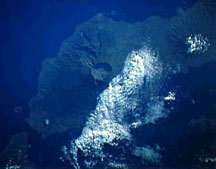Scientists find lost Indonesian civilization
Scientists have found what they believe are traces of the lost Indonesian civilization of Tambora, which was wiped out in 1815 by the biggest volcanic eruption in recorded history.

Mount Tambora's cataclysmic eruption on April 10, 1815, buried the inhabitants of Sumbawa Island under searing ash, gas and rock and is blamed for an estimated 88,000 deaths. The eruption was at least four times more powerful than Mount Krakatoa's in 1883.
Guided by ground-penetrating radar, researchers from the University of North Carolina at Wilmington and the Indonesian Directorate of Volcanology recently dug in a gully where locals had found ceramics and bones. They unearthed the remains of a thatch house, pottery, bronze and the carbonized bones of two people, all in a layer of sediment dating to the eruption.
University of Rhode Island volcanologist Haraldur Sigurdsson, the leader of the expedition, estimated that 10,000 people lived in the town when the volcano erupted in a blast that dwarfed the one that buried the Roman town of Pompeii, reports the AP.
I.L.
Subscribe to Pravda.Ru Telegram channel, Facebook, RSS!





